Teti's Pyramid, built in Egypt's Old Kingdom, displays impressive architectural skill and expertise. Explore the Teti pyramid's rich history, architecture, texts, and the captivating necropolis, revealing ancient Egypt's wonders!
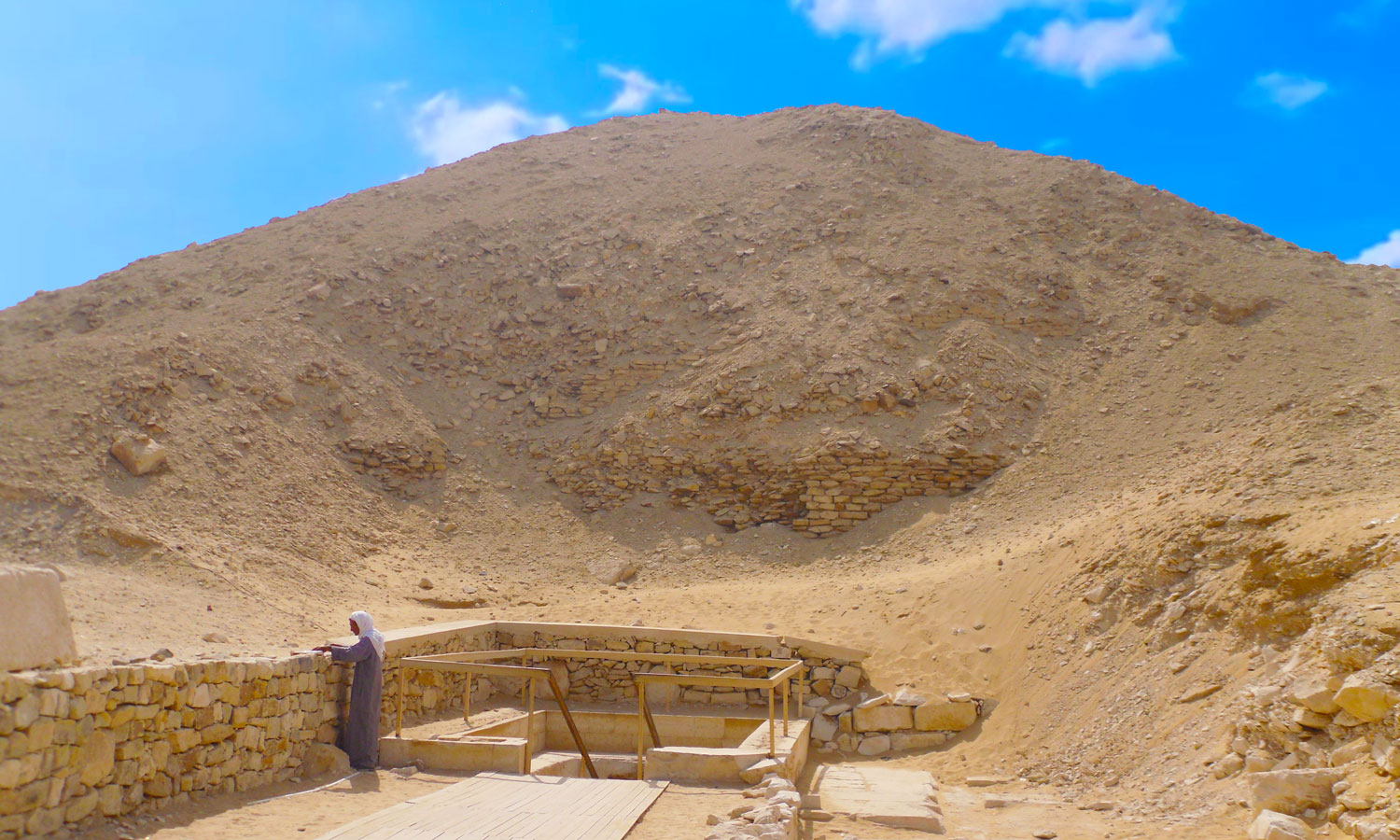
| Overview | |

|
|
| Location | Saqqara, Giza |
| Constructed | Sixth Dynasty |
| Type | Smooth-sided Pyramid |
| Height | 52.5 m |
| Base | 78.75 m |
| Volume | 107,835 m3 |
| Slope | 53° 07' 48" |
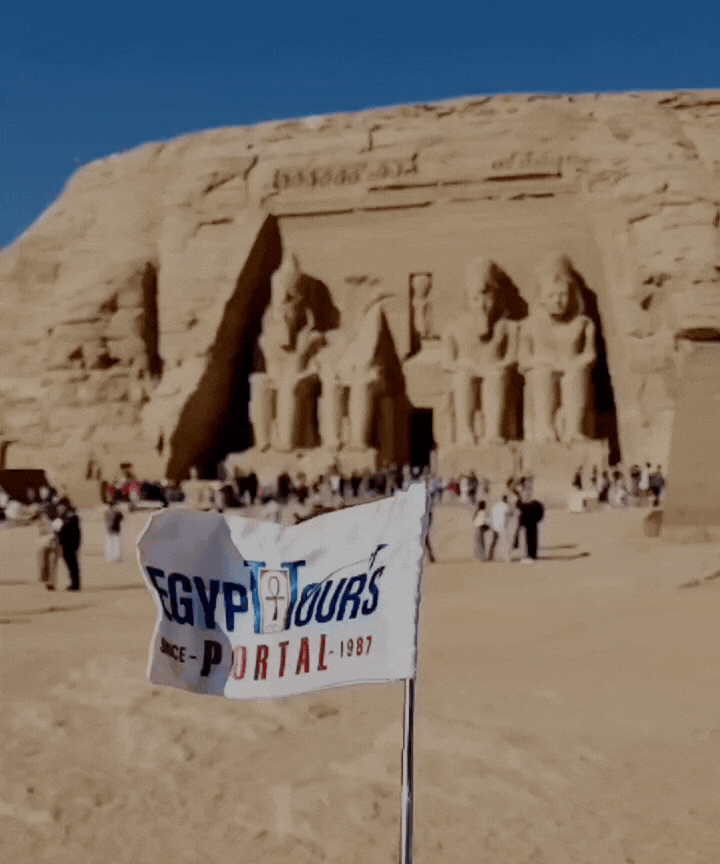
The Pyramid of Teti is an extraordinary marvel of architectural brilliance. It showcases the power and incredible knowledge of the ancient Egyptians, who utilized them by immortalizing their names in the history books. During the 6th dynasty of the old kingdom of Egypt, Saqqara was able to transform into a golden garden of Pyramids. It is known to be the second pyramid in the history of Egypt, which possessed pyramid texts.
This enchanting pyramid can provide an ideal and comprehensive glimpse into the heart and soul of the creative minds of the ancient Egyptians. This smooth-sided wonder will shed light on several very important pieces of information and tales about the innovation of art and architecture across history.

Pharaoh Teti reigned during the Old Kingdom of Egypt, which commissioned the construction of a pyramid around 2345–2323 BC, marking his final resting place. Known as the "Places of Teti Endur", this pyramid became famous for housing the Pyramid Texts, significant religious writings from that era. Teti ruled for 12 years, his principal wife being Iput, daughter of Unas, the last king of the 5th dynasty. The pyramid was discovered in the 1850s and gradually buried by shifting sands. Historian Manetho proposed a theory suggesting Teti's assassination by his own bodyguards. In 1882 AD, Gaston Maspero initiated its excavation, with complete exploration occurring between 1907 and 1965. The site features remarkable structures like two Queens' Pyramids, a satellite Pyramid, two cult buildings, and a mortuary Temple.
Explore the enigmatic Pepi I Pyramid: uncover its history, location, structure, texts, and the complex content within. Discover Pepi I's intriguing legacy.
Read MoreDespite the passage of time, the pyramid remains well-preserved, resembling a small hill concealing underground corridors and chambers. Access to the funerary chambers is through sloping shafts and low passageways, leading to vaulted roofs adorned with intricate star-patterned blocks, although some have shifted inward over time. The design and layout of Teti's pyramid influenced subsequent 6th dynasty Pharaohs, many of whom were interred in the southern Saqqara necropolis, evident from the courtiers' tombs nearby. The pyramid's significance extends to its connection with the remarkable Serapeum through an avenue lined with golden Sphinxes, a route hidden beneath the sands of Saqqara. Over the years, numerous excavations have revealed the historical richness of this extraordinary site.
This magnificent smooth-sided pyramid is located in the Saqqara green belt field of pyramids, which was established by Pharaoh Teti (2345 – 2323 BC), who was the first ruler of the 6th dynasty which was located near the Step Pyramid of Djoser (2667–2648 BC) which has the power to provide epic Giza Pyramids Complex and the Red Pyramid.
The pyramid is found 50 minutes away from central Cairo, but in order to get around the city, it is advised to book with a travel agency that will provide a vehicle with a skilled driver and a seasoned tour guide across the pyramids of Saqqara.
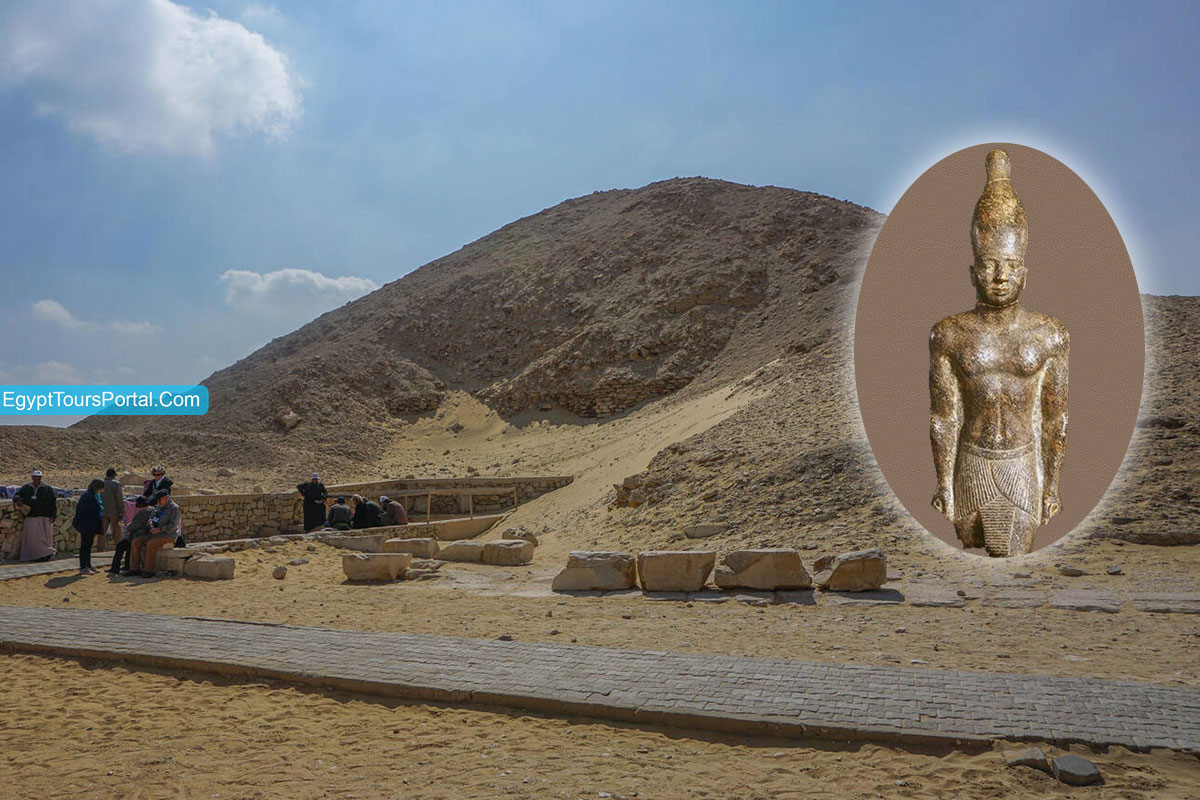
Teti ruled as the first king of Egypt's Sixth Dynasty around 2323–2291 BC, where his reign spanned 12 years, and he was succeeded by Userkare after his death. He was buried in Saqqara, and his legacy lies in his family tree and the monumental changes in Egypt during his time. Teti had multiple wives and children, among them being Iput, Khuit, Khentkaus IV, Naert, and possibly others. He fathered several sons, notably Pepi I, Tetiankhkem, and Nebkauhor, along with at least nine daughters who were named after his mother, Sesheshet. These daughters married prominent individuals and were linked to various viziers and officials of the time.
During Teti's rule, significant developments occurred in Egypt's funerary architecture, with high officials constructing grand tombs, including the renowned mastaba tomb of his vizier, Mereruka, featuring 33 elaborately decorated rooms. This period witnessed a shift in wealth distribution from the central court to officials, which signified the eventual decline of the Old Kingdom. Greek historian Manetho claimed that Teti was assassinated by his palace guards in a plot involving the harem. He was succeeded briefly by Userkare, and Teti's burial took place in the royal necropolis at Saqqara. Teti's mother "Queen Sesheshet" played a pivotal role in reconciling warring factions within the royal family and facilitating her son's ascent to the throne.
Her tomb was discovered in 2008 within this 4,300-year-old pyramid at Saqqara, which is marked for being the 118th pyramid found in Egypt. Recent archaeological discoveries at Saqqara in 2021 included over 50 wooden sarcophagi dating back to the New Kingdom period of ancient Egypt and a 13-foot-long papyrus containing excerpts from the Book of the Dead. The pyramid also has the funerary temple of Queen Neith who was one of Teti's wives.

Teti's great pyramid diverges from cardinal alignment but closely mirrors the design of Djedkare Isesi's pyramid. The entrance on the north side of the chapel leads down a 1,823-meter passage, which was once obstructed by granite and limestone debris from theft. The pyramid has a volume of 107,835 m3 (141,043 cu yd), 52.5 m (172 ft; 100 cu) high with a base length of 78.75 m (258 ft; 150 cu), which was constructed with smooth sides that were covered later with a marvelous layer of casing of limestone and a core of blocks of limestone and a fill of debris. The pyramid's interior is made of an antechamber, a subterranean chamber, and a burial chamber. Teti's pyramid measures 78.5 meters per side at the base and stands 52.5 meters tall, equaling 150 cubits and 100 cubits in the Egyptian Royal cubit measurement. The structure's core is made of locally quarried stone and debris fill, which was once covered with limestone but is now removed, thus causing structural shifts.
The descending corridor unfolds into various sections like hallways and a bedroom with broken granite harrows and culminates in the king's funerary chambers. The six-meter room inside, with alternating limestone and granite, contains fragmented granite harrows. The horizontal passage connects a Serdab, antechamber, and burial chamber, all aligned east-west. The burial rooms are adorned with Pyramid Texts, aiding the king's rebirth. The burial chamber holds an unfinished sarcophagus, a fragmented lid, and a basic canopic container. The burial chamber had a ceiling that contained decorations of gold stars on a dark blue background. The tomb offers a magnificent entrance to the underworld. Despite ancient looting, remnants like a club head with Teti's name, an unfinished greywacke sarcophagus, a canopic jar, and discarded stone objects were discovered during the excavation. A plaster mold of a death mask, which was believed to be Teti's likeness, survived, marking the only true royal portrait from the Old Kingdom.
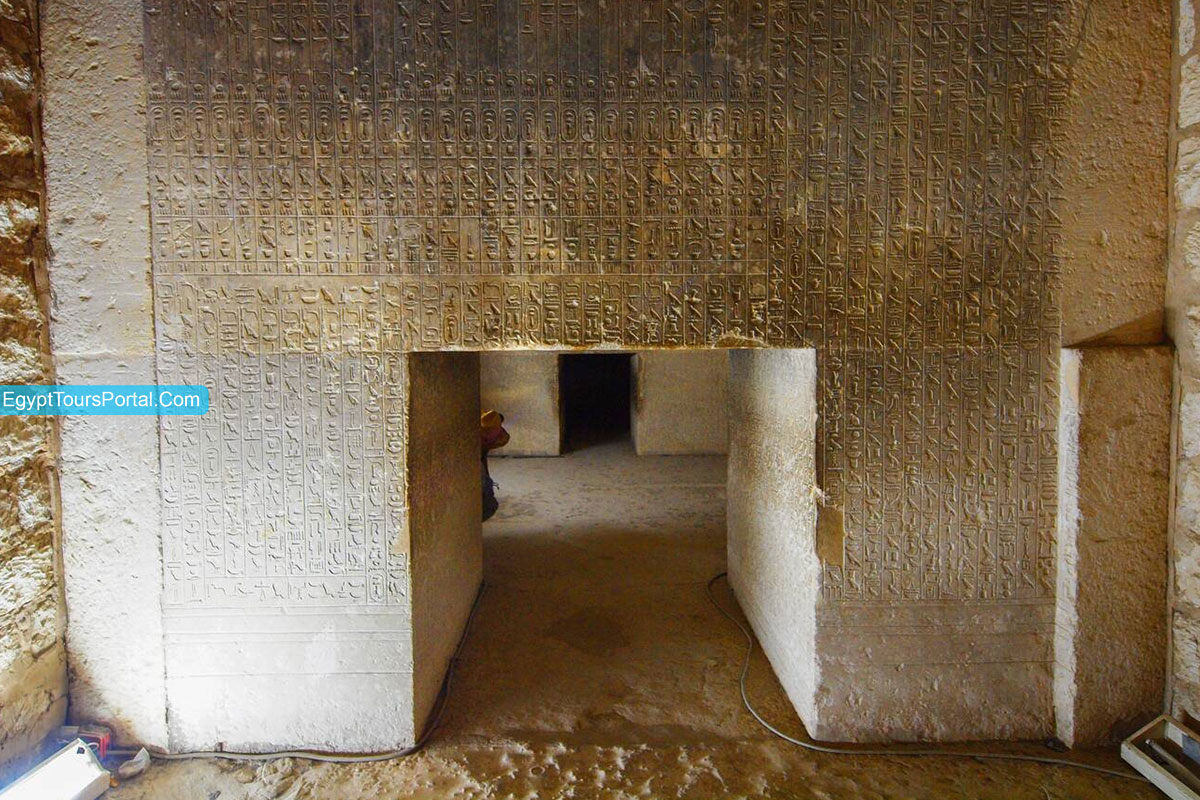
The pyramid of Teti has an entrance on the north side at the ground level along the central axis. The entrance is covered with flagstones, and above it is a small rectangular entrance chapel. The painted reliefs on the sidewall of the pyramid showcase usual offerings bearers, and against the back wall of the chapel is a false door of black basalt.
The roof of the chapel was made of a single limestone slab, which was decorated with a pattern of stars. There are a couple of storage rooms and basic components and layouts similar to the pyramids of Djedkare and Unas. The walls of the descending passages are covered with granite, and there is a passage that opens into a small corridor chamber followed by a horizontal passage.
There are three portcullises to block the passage. There is a horizontal passage that opens into the antechamber, which is located under the center of the Teti pyramid. There is a room with three niches to the east that holds some statues of the king, and in the complete opposite is the burial chamber that contains a basalt sarcophagus.
On the walls of the burial chamber are the pyramid texts, which remain in very good condition. The mortuary temple of Teti was able to allow archaeologists to understand that the basic plan of the structure conformed to the scheme which appeared to be a standard as shown in the pyramid of Djedkare. The entrance is in the south section of the eastern wall.
There is a traverse corridor leading to the entrance hall that is located along the temple's axis, and the hall leads to the colonnades' open court. There is an altar made of alabaster holding beautiful decorations in the center of the open court. A second traverse corridor allows access to containers in the south and north of the entrance hall and the court. A satellite pyramid of Teti lies to the south of the corridor.
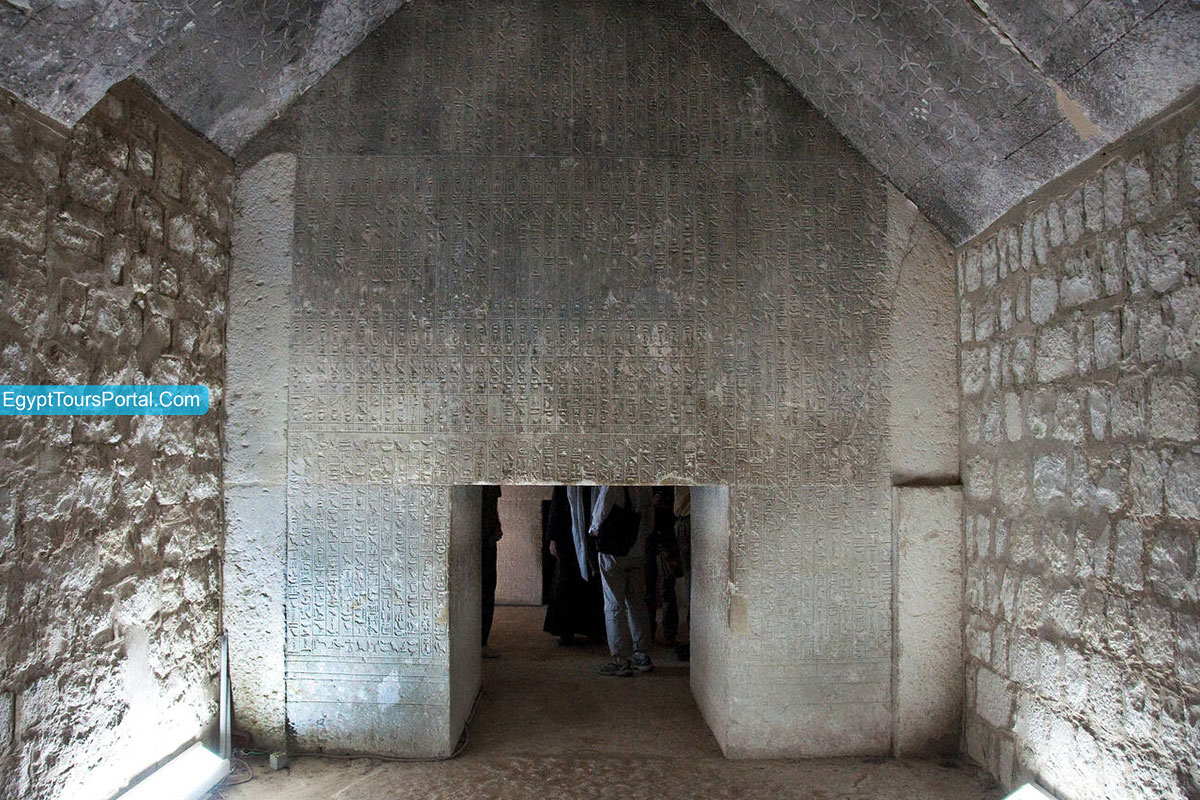
Teti's pyramid complex was inspired by Djedkare Isesi's design and resembled Abusir funerary complexes, which were comprised of several key structures. The valley temple was replaced by an Old Kingdom temple for Anubis that was connected to a well-known funerary temple through a causeway. Teti's temple was similar to Unas's, which had a distinctive floor deviation from the typical temple axis, thus granting access through a north-south hallway instead of aligning directly east-west. The main axis led to a hall, which is the "Room of the Greats" displaying the royal family and court members accompanying the king's eternal journey. This opened into a courtyard surrounded by colonnades for daily offerings and rituals, with the only exit leading westward to the sanctuary.
Delve into the mysteries of Abusir Necropolis & explore its rich history, pyramids, temples & tombs. Uncover fascinating facts about mummies and ancient secrets
Read MoreWithin the enclosed court, a sacred area for the king's priests was a chapel housing five Naos with statues depicting the king as principal deities. This section also held a private room with the king's black basalt false door stela that was crucial for funeral rites and rows of stores accessible through corridors. Another crucial element was the satellite pyramid within its enclosed court, which is situated southeast of the royal pyramid and is accessible through corridors and halls. This small pyramid housed an underground chamber and featured two landscaped basins in its courtyard, possibly indicating ritual practices associated with the sun's path.

The Teti Necropolis is a significant part of the Teti funerary complex, situated within the opulent expanse of the Saqqara necropolis. Teti's remarkable reputation and destiny left a lasting impression on his successors, who revered him as a potent spiritual intermediary. His legacy reverberates throughout history, evidenced by the reverence shown by courtiers and the monumental structures he commissioned. In honoring his main wives, Teti constructed individual pyramids, each accompanied by a worship pyramid. This necropolis, stemming from the sixth dynasty, boasts diverse tombs and complexes:
During the Middle Kingdom of Egypt (2030 - 1650 BC), tombs belonging to royal priests, who are called Sekoueskhet and Sa-Hathor-Ipy, were unearthed on the eastern of Teti's pyramid. During the New Kingdom (1570 – 1050 BC), additional graves were incorporated near the funerary complex, with notable figures such as Ramses II, Khaemwaset, and the High Priest and royal prince of Ptah participating in the pyramid's restoration. Around 540 BC, the Anubis Temple was constructed atop the Teti funerary complex, maintaining its sacred allure for generations. The pyramid's dromos head to the Serapeum of Saqqara, further enriching the significance of this historical site.
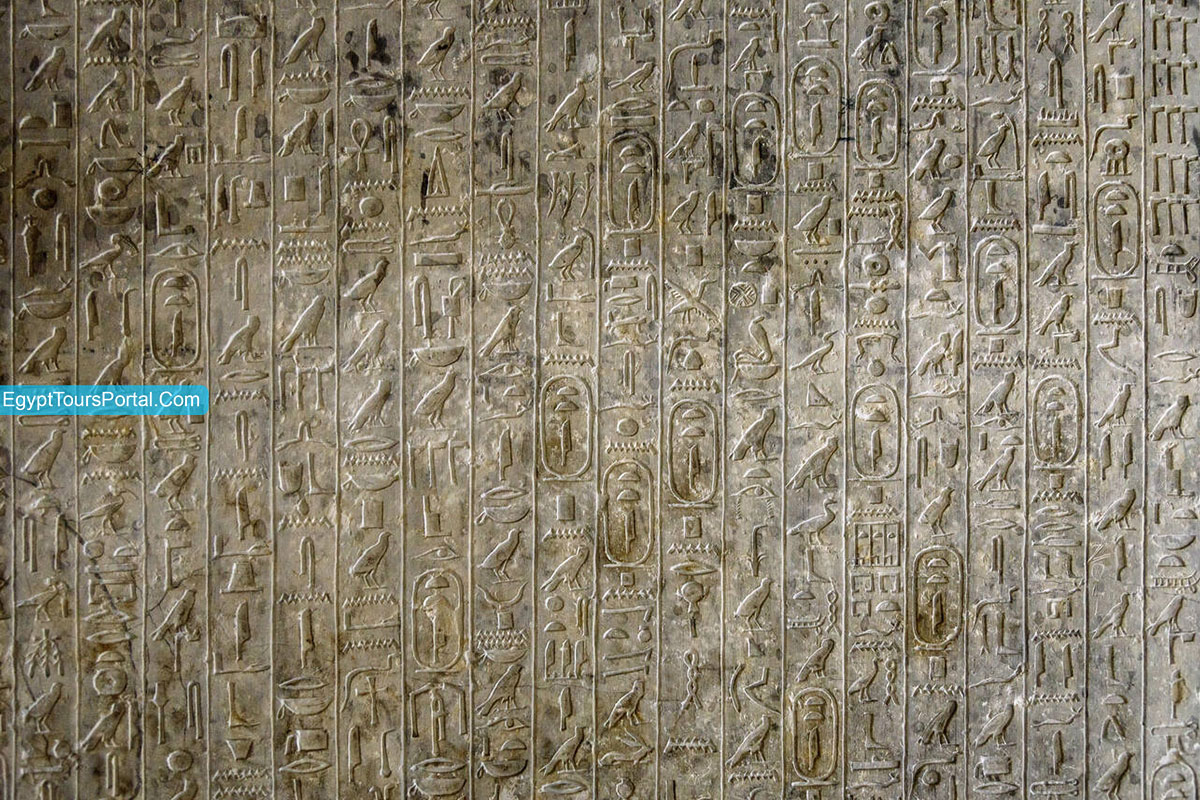
The Pyramid Texts date back to around 2400–2300 BCE, thus making them the oldest religious texts in ancient Egyptian history. They were carved onto the walls and sarcophagi of pyramids at Saqqara during the Old Kingdom, these texts were exclusive to pharaohs and primarily aimed at aiding their journey into the afterlife. They were distinct from later texts like the Coffin Texts and Book of the Dead, which focused solely on the pharaoh’s transformation into an Akh where they could join the gods in the afterlife. Divided into two categories, the Sacerdotal texts were ritualistic, involving offering spells and instructional recitations, likely formulated during the earlier dynasties.
The Personal texts were more individualized, guiding the spirit through its transition and protection, featuring the oldest and most cryptic writing styles. These texts were meant to be chanted, detailing the pharaoh's actions and invoking the gods' aid. They often highlighted the pharaoh’s accomplishments and deeds during their rule to reassure both the living and the departed. Rituals like the opening of the mouth ceremony aimed to ensure the deceased could function in the afterlife. These texts were recited in a specific sequence within the pyramids, likely corresponding to the chambers' significance and usage during burial and ritual procedures.

The Pyramid of Teti is an ancient Egyptian pyramid located in Saqqara, Egypt. Here are some key facts about it:
Egypt is the home to some of the most magical constructions in the world, so don't miss the chance to explore this majestic land through our Egypt vacations Tours.
Private 4 Days Cairo Tour Packages for British Travelers 4 days Cairo Egypt Tour pac...
Tour Location: Cairo – Giza...
5 Days Cairo and Alexandria Tour Package For British Travelers 5 days Cairo and Alex...
Tour Location: Cairo/Giza/Alexandria...
6 Days Cairo, Luxor & Aswan Tour Package For British Travelers 6 days Cairo, Lux...
Tour Location: Cairo/Giza/Aswan/Luxor...
Amazing 7 Days Cairo and Hurghada Holiday for British Travelers 7 Days Cairo & H...
Tour Location: Cairo – Giza – Hurgh...
The entire country of Egypt deserve to be explored with its every heavenly detail but there are places that must be seen before any other such as the breathtaking Hurghada's red sea, The wonders of Cairo the pyramids of Giza, the great sphinx, the Egyptian Museum, Khan El Khalili Bazaar, the wonders of Luxor like Valley of the Kings, Karnak & Hatshepsut temple and the wonders of Aswan such as Abu Simbel temples, Philea temple, Unfinished obelisk and The Wonders of Alexandria like Qaitbat Citadel, Pompey's Pillar and Alexandria Library. Read more about the best places to visit in Egypt.
If you want to apply for a Visa On Arrival that lasts for 30 days then you should be one of the eligible countries, have a valid passport with at least 6 months remaining and pay 25$ USD in cash, as for the E-Visa for 30 day you should have a valid passport for at least 8 months, complete the online application, pay the e-visa fee then print the e-visa to later be presented to the airport border guard. You could also be one of the lucky ones who can obtain a free visa for 90 days. Read more about Egypt travel visa.
Egypt has a variety of delicious cuisines but we recommend “Ful & Ta’meya (Fava Beans and Falafel)”, Mulukhiya, “Koshary”, a traditional Egyptian pasta dish, and Kebab & Kofta, the Egyptian traditional meat dish.
The best time to travel to Egypt is during the winter from September to April as the climate becomes a little tropical accompanied by a magical atmosphere of warm weather with a winter breeze. You will be notified in the week of your trip if the Climate is unsafe and if any changes have been made.
You should pack everything you could ever need in a small bag so you could move easily between your destinations.
We have been creating the finest vacations for more than 20 years around the most majestic destinations in Egypt. Our staff consists of the best operators, guides and drivers who dedicate all of their time & effort to make you have the perfect vacation. All of our tours are customized by Travel, Financial & Time consultants to fit your every possible need during your vacation. It doesn't go without saying that your safety and comfort are our main priority and all of our resources will be directed to provide the finest atmosphere until you return home.
You will feel safe in Egypt as the current atmosphere of the country is quite peaceful after the government took powerful measures like restructuring the entire tourist police to include all the important and tourist attractions in Egypt. Read more about is it safe to travel to Egypt.
Wear whatever feels right and comfortable. It is advised to wear something light and comfortable footwear like a closed-toe shoe to sustain the terrain of Egypt. Put on sun block during your time in Egypt in the summer to protect yourself from the sun.
The best activity is by far boarding a Nile Cruise between Luxor and Aswan or Vise Versa. Witness the beauty of Egypt from a hot balloon or a plane and try all the delicious Egyptian cuisines and drinks plus shopping in old Cairo. Explore the allure and wonders of the red sea in the magical city resorts of Egypt like Hurghada and many more by diving and snorkeling in the marine life or Hurghada. Behold the mesmerizing western desert by a safari trip under the heavenly Egyptian skies.
There are a lot of public holidays in Egypt too many to count either religious or nation, the most important festivals are the holy month of Ramadan which ends with Eid Al Fitr, Christmas and new years eve. Read more about festivals & publich holidays in Egypt.
Egypt is considered to be one of the most liberal Islamic countries but it has become a little bit conservative in the last couple of decades so it is advised to avoid showing your chest, shoulders or legs below the knees.
Arabic is the official language and Most Egyptians, who live in the cities, speak or understand English or at least some English words or phrases. Fewer Egyptians can speak French, Italian, Spanish, and German. Professional tour guides, who work in the tourism sector, are equipped to handle visitors who cannot speak Arabic and they will speak enough English and other languages to fulfill the needs of all our clients.
The fastest way is a car, of course, a taxi. If you are in Cairo ride a white taxi to move faster or you could board the fastest way of transportation in Egypt metro if the roads are in rush hour.
The temperature in Egypt ranges from 37c to 14 c. Summer in Egypt is somehow hot but sometimes it becomes cold at night and winter is cool and mild. The average of low temperatures vary from 9.5 °C in the wintertime to 23 °C in the summertime and the average high temperatures vary from 17 °C in the wintertime to 32 °C in the summertime. The temperature is moderate all along the coasts.
It is the home of everything a traveler might be looking for from amazing historical sites dating to more than 4000 years to enchanting city resorts & beaches. You will live the vacation you deserve as Egypt has everything you could possibly imagine.









